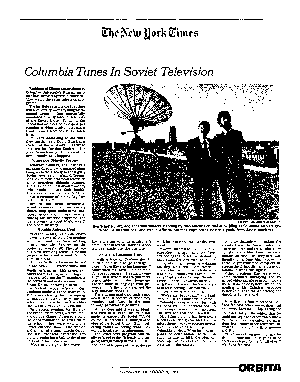Columbia Tunes In Soviet Television
Residents of Siberia and students at Columbia University’s Russian institute have something new in common: They watch the same television programs. The institute says it is the first time that a university – or any non-governmental group – has successfully monitored directly internal telecasts of the Soviet Union. To do it, the school had an electronics exper put together a video monitor that scans transmissions from Soviet TV satellites.
“It’s very interesting to see what they watch,” said David Barrick, a student at the W. Averell Harriman Institute for Advanced Studies of the Soviet Union. “It’s great to see their point of view of the news exactly as it happens.”
Conscious Didactic Purpose
Jonathan Sanders, the institute’s assistant director, who acknowledges being addicted already to the nightly Soviet news, said: “What differentiates Soviet from American television is its conscious didactic purpose. There is a helpfulness about it – they help people improve their health. There are no commercials, but then it’s all a commercial for one big firm, U.S.S.R. Inc.”
Besides the news broadcasts, Soviet television includes variety shows, soap opera melodramas, cartoons, sports and cultural events, cooking and exercise programs, and many programs shout World War II and Soviet industry.
Movable Antenna Used
 “Lots of tractors,” said Ken Schaffer, who designed and assembled the monitoring equipment and has been working closely with Mr. Sanders on the project since early 1983. The institute has been receiving Soviet television programs for about a week from 4 P M to a 8 A.M.
“Lots of tractors,” said Ken Schaffer, who designed and assembled the monitoring equipment and has been working closely with Mr. Sanders on the project since early 1983. The institute has been receiving Soviet television programs for about a week from 4 P M to a 8 A.M.
A movable dish antenna on the roof of the School of International and Public Affairs, at 118th Street and Amsterdam Avenue, is capturing signals beamed from the TV satellites to the northern and eastern areas of the Soviet Union, including Siberia.
At present the graduate and under. graduate students at the Russian institute are viewing the programs as an extracurricular activity, but the school has plans to use the video monitor in its regular study courses.
On a recent evening, Mr. Barrick and two fellow students, Arthur Small and Connie Klaner, clustered around the video monitor on the 12th floor of the school. They were watching a Soviet exercise show Two women and a man of strong muscle definition, but little facial expression, lifting and replacing a ball to the piano notes of “The Entertainer.”
“Move to the right, then move to the left, along with the music, let’s start,” translated Mr. Barrick, a second year student at the institute.
An Aid In Language Study
“With a book of Dostoyevsky, it takes a half hour to go through a page; it’s not like a living language,” commented Mr. Small, a Columbia College sophomore. “Having it come at you in a stream makes you more comfortable with the language. There’s more to language than just words it’s the intonation and the way Russians speak it.’,
The students said they understood about 50 to 60 percent of what they watched, and filled in the gaps through performers’ gestures.
Mr. Sanders said it was an idealized view of Russian life, “It’s not made for export; it’s Soviet TV. of course, it presents a manipulated view of the Soviet Union. But inculcating values – seeing what they want to inculcate is interesting.”
The Soviet news programs continually referred to the “friendly and out-going foreign policy of the U.S.S.R.” and the “willingness of the Soviets to work for peace and nuclear disarmament.”
“We’re interested in more than pure Kremlinology,” said Mr. Sanders, adding that he wanted students to understand the personalities of Russians, who might seem very distant and depersonalized to Americans.
Plans for the monitor include using it to study formally what Mr. Sanders calls ”high politics” – top officials in action – as well as Soviet interaction with the third world, the Soviet style of news reporting, Russian social activities, even sports training
“We’re just beginning,” Mr. Sanders said. “it’s a whole new universe.” Columbia hopes to assemble, with Mr. Schaffer as technical consultant, several more video monitors. This first one cost about $35,000.
Mr. Schaffer, who invented the wireless electric guitar and wireless microphone, had to overcome several technical obstacles to complete the Columbia project. When he first proposed the video monitor to the Russian institute in 1983, the idea had been rejected by several other universities in the country.
A major obstacle was tracking the signals from the Soviet satellites. There are four, and the satellites are not stationary like American communication satellites; they orbit continually in a loop high above the earth. A programmed computer instructs the 11-foot dish antenna at Columbia to track the signals.
Other problems that were overcome included modifying the received video signals to accommodate the Russian color system (which, according to Mr. Schaffer, produces better color than the American) and decoding Soviet sound with a black box he monikered “d-Cyberia.”
Now that he has succeeded, Mr. Schaffer said other universities had expressed interest in duplicating the Columbia setup. He added that he could put together other video monitors to receive television transmissions from many other countries, including Ecuador, Brazil, Argentina and France.
“Five years from now — or maybe 10 — international TV is going to be pretty much pro forma for all of us,” Mr. Schaffer said.
